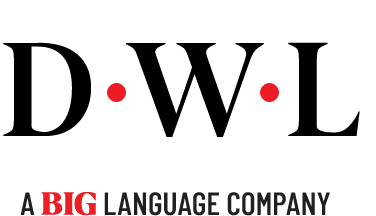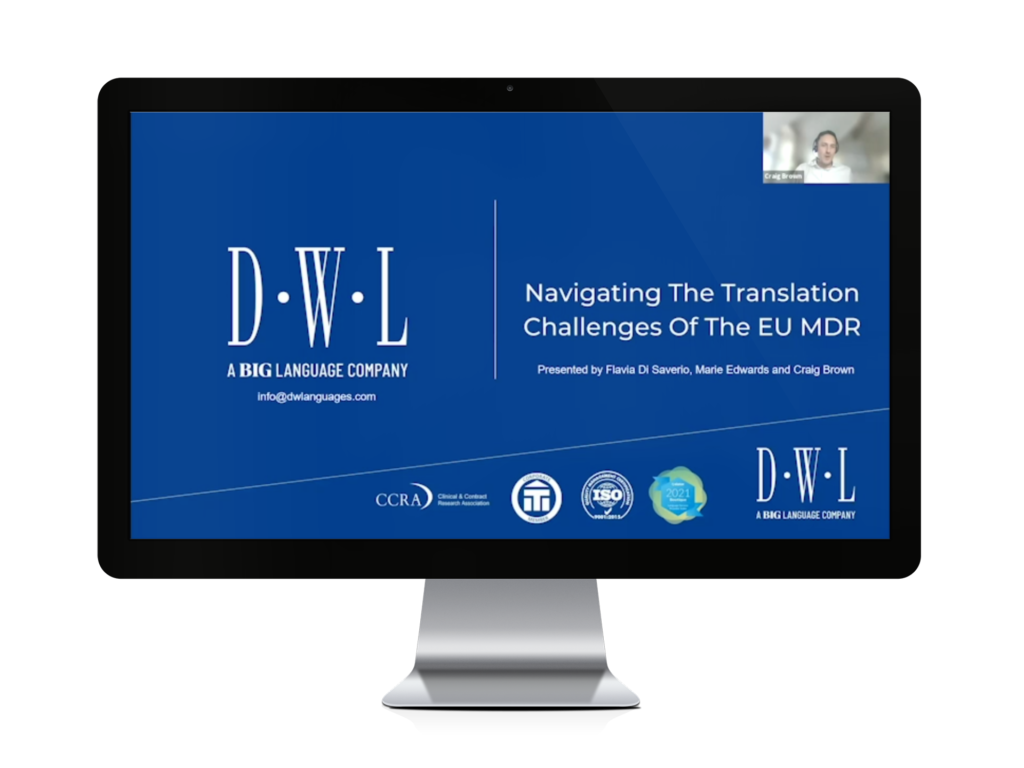Were it not for the COVID-19 pandemic and ensuing lockdowns, we would be traveling to conferences in Europe, discussing the latest life sciences industry developments, attending seminars and, of course, welcoming people to our exhibition booth.
While we can’t meet in person this year, we are excited to welcome you to our virtual booth in the conference. To get started, here are answers to the five questions the DWL team is asked most regularly at life sciences conferences.
- What do you do?
- How long does it take to translate a document?
- Do you manage linguistic comments from EU member states for marketing authorisation applications?
- With how many translators do you work?
- How secure are your processes and systems?
→ Haven’t seen us at conferences? Ask us another question: To find out more or for additional insight, contact us at [email protected] to set up a meeting.

1. What do you do?
Established in 1962, DWL is a specialist Language Service Provider (LSP), supplying high-quality medical and pharmaceutical translations to the life sciences industry. We support global pharmaceutical, medical device companies, and research organizations with customized and high-quality translations of product information, clinical research documents, pharmacovigilance, and post-marketing activities, with a particular focus on EU regulatory affairs. Our services are delivered according to ISO 9001-audited project management and Quality Control procedures.
In 2021, DWL joined the BIG Language Solutions family, bringing life sciences expertise to a group of high-performing LSPs, offering end-to-end language services across multiple industries.
The DWL approach remains:
- In-house expertise in medical and regulatory affairs;
- A friendly, personalised approach to complex customer requirements;
- Single-point of contact established early on in the sales process;
- Resilient global supply chain of experienced linguists;
- Project management teams from diverse backgrounds within the translation industry that go the extra mile; and
- Selective application of technology, including Neural Machine Translation in 2021.
2. How long does it take to translate a document?
On average, it takes a professional (human) medical translator one working day to translate and check 2,000-2,500 translated words in their specialist field, without assistance from technology. This equates to around 260-300 words per hour. Some translators work slower than this; others at terrific speeds.
To revise the translation (an essential step in the process), a second translator may spend roughly 1,300 words per hour. Internal quality control specialists may review as many as 4,000 words per hour.
There are methods at our disposal to speed this process up further, depending on the project, timeframe, and required output. For example, is the text for information only, in which case you might exchange style for far higher speeds? Or, is your dossier for submission to a national authority, in which case, accuracy, and compliance are as important as speed.
- Our Computer-Aided Translation (CAT) tool, memoQ, can identify repeated segments of text in a document or pre-translate a document against existing translation memories. This saves time without sacrificing quality or consistency.
- Neural Machine Translation (NMT) is the latest tool in our arsenal. Trained on vast amounts of high-quality translation data, our machine translation tool can expedite the initial stages of the translation process. Quality is maintained through a rigorous human post-editing step. Of course, NMT is only deployed for specific applications because patient safety is of paramount importance.
- Another method is collaboration. It is possible for multiple translators to work on the same document simultaneously and even share translation memories. However, if consistency of style is important then the resulting translation must be harmonised.
In summary, the time it takes to produce a translation depends on the number of words, the subject matter, and the quality you require for your target audience.

3. Do you manage linguistic comments from EU member states for marketing authorisation applications?
Yes, we assist our customers at various stages of the centralized application process and can work with you from day 1, including key deadlines from Day 210 to Day 235.
Our approach is to gather enough information at the beginning of the process to fit seamlessly into your workflow. This can include liaising with EU member states or local company affiliates, ensuring that Quality Review of Documents (QRD) requirements are met and indicated on the submission checklist and that the QRD Form 2 is completed.
You will have a single point of contact at DWL for the entire submission who will coordinate the translation process for you, ensuring that updates to product information are implemented accurately across all EU languages in time for the submission deadlines of the European Medicines Agency (EMA).
On Day 229, we can also liaise directly with member state health authorities to come to an agreement on any linguistic comments and ensure that the translations will not delay your submission. Following this, a submission-ready package will be prepared with all required versions in Word and bookmarked PDFs.
4. With how many translators do you work?
Our global network of translators comprises more than 1,000 approved translators and revisers, each of whom is selected based on both their linguistic skills and medical expertise.
Our linguists come from a wide variety of backgrounds. In addition to being experienced medical and pharmaceutical translators, many are also trained physicians, pharmacologists, medical scientists, healthcare professionals, and legal experts.
Most of our translators work in their mother tongue and are generally based in the country of their target language. This ensures they remain up to date with industry and language developments, thereby enabling them to produce translations that accurately reflect their respective fields as well as their cultural contexts.
Following an acquisition by BIG Language Solutions in July 2021, our global footprint has grown dramatically. The rise in operational capacity and geographical reach allows us to recruit and evaluate an even larger pool of translators.
5. How secure are your processes and systems?
Translation management at DWL is handled within industry-standard translation management software (TMS). This ensures data is securely held in dedicated servers with access granted according to a rights management system.
Companies in the BIG Language Solutions family also have access to LanguageVault®, a proprietary translation management platform that has been designed to ensure complete security throughout the translation workflow. This includes end-to-end SOC 2 Type II security certification and ISO 27001 accreditation, ensuring compliance across people, processes, and technology. Find out more at biglssites1.wpengine.com/languagevault.
Haven’t seen us at other conferences? Find out more or for additional insight, contact us at [email protected] to set up a meeting.








